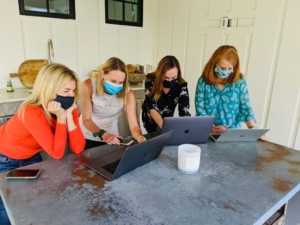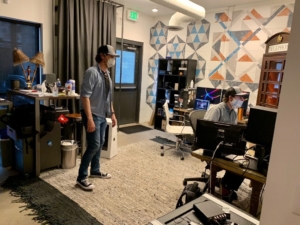How to create engagement and empowerment in a Pandemic.

Sonya Law, of SL Human Resources Consulting, received her Human Resources Degree from Deakin University and completed her Teaching Degree with Monash University and recently Masters Business (MBA) in 2018, providing opportunities to work and study abroad in Europe and Asia. Sonya has recruited 1,000’s of people and has a talent for getting the right people on the bus in the right seats and creating a positive inclusive workplace culture for many organization’s in the following industries, Telecommunications, Government, Pharmaceutical, Water Utilities, FMCG and more recently Mining and Construction for Sullair (Hitachi Group Company) where she achieved innovation award in 2020 for solving societies problems for social connectedness during the pandemic. In 2020 Sonya has returned to consulting to spread her wings and pursue her passion for consulting, to assist companies to develop their human resources and achieve cultural and strategic alignment and high performing organizations. She writes from experience about how to create engagement and empowerment in a pandemic.
Sonya can be contacted on 0421 716 949 or direct message on LinkedIn Profile.
During the Spanish Flu back in the early 1900’s composers created the most beautiful music and artists the most exquisite masterpieces. During the pandemic people fell into two groups: negative doomsayers and those who took the opportunity to be creative, innovative with a journey of self-discovery.
As a Human Resources Manager, I fell into the second group: how do I create engagement and empowerment in a Pandemic?
Firstly, I started with a Pulse Survey, to ask the employees what they felt they needed to be connected and effective in their work. Overwhelmingly over 90% of employees wanted a refresh of the employee benefits and recognition program and the biggest challenge cited was the virtual office. With those working from home, ‘social connectedness’ was the missing link. We discovered as human beings, we are social animals and need to connect with other humans. We weren’t getting our hit of oxytocin the ‘love’ drug and the ‘safety’’ of social bonds. During the pandemic, there was also the financial impact on families with some going to a single income or reduction in earning capacity.
So, given these two problems of social connectedness and financial impact, we engaged ‘Reward Gateway’ a company that works with companies too create a digital platform that connects people socially and provides shopping discounts to everyday purchases of groceries and petrol. Bolting on an e-card that recognized employees working from home, birthday’s and work anniversaries, shared social news, photos and wellness tool. The employees were involved in look and feel of the wireframe, e-card design and naming of the platform – RAZZLE, connect, celebrate and reward.
The program was inclusive, all year round and benefited not only all employees but their families. Making it a positive story around the dinner table during an overload of bad news stories during the pandemic, employees spoke proudly of their workplace to friends and family and above all felt valued.
Managing Directors and CEO’s became panicked about productivity and performance and so presented the challenge to Human Resources Leaders, how do we ensure productivity doesn’t drop during the pandemic with employees now working from home? The answer, is employee engagement, provide an environment where people feel safe, cared for emotionally and physically, as a leadership team, our role shifted to leading with empathy, kindness and compassion. Emerged the empathetic listener, we educated our managers on “How to have a mental health conversation,” to be able to provide support, listen without judgement, encourage action and check in on employees during isolation and lockdown periods during the pandemic.
The Australian Institute of Management (AIM) polled participants in a workshop during the pandemic and interestingly 13% found it easier working from home, but majority found it harder 27% and 60% same but different, requiring them to adapt to new ways of working which was stressful for most. The arising issues were an ‘over attendance’ employee, who were working longer days, struggling to balance home and work life which blurred into literally ‘ground hog day’ for most. It became evident to leaders the need to ask employees about their ‘self-care routine’ how are they going balancing their family and work commitments, are the getting quality sleep, are they better to have a ‘doona day’ (Aussie Speak for down day) a day off where they don’t have to show up on ZOOM, to rest and recover in what was a very busy and stressful period for employees.
Employers and leaders who recognized this and genuinely cared for their employees and found new ways of connecting virtually, won their people over in a wholistic sense. They weren’t just the worker bee, they were a human being, not just a number. And they saw their manager in a new light, often appearing more casual in ZOOM meetings in their home environment which included guests’ appearances by family and their pets, helped employees to see their leaders as human just like them.
The senior leadership team, emerged with a new skill as the empathetic learner, people managers who listened to what their people needed to perform and supported them by removing roadblocks and trusting them in this process. We’re being informed by the thinking and opinions of the people who matter most employees who need to be trusted to get the work done whilst balancing the business needs of the organization and navigating tricky conversations on the profitability to shareholders. Businesses who found new ways to connect virtually and developed their empathetic leadership style successfully navigated the pandemic whilst maintaining productivity at least to same level as last year, and for those who were opportunistic and quick to adapt, growth in some areas of business.
Some employees describe a sense of belonging, a renewed sense of commitment and purpose to the cause and empowered to make decisions impacting their work. The pandemic hit the stop button for a lot of businesses but in doing so this reset and recalibration has given us new ways to collaborate and connect virtually and flexibility to working families whilst still achieving the strategic vision.
For more information on our learning programs, please visit us at Learning Without Scars.







